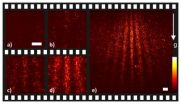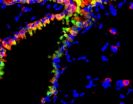(Press-News.org) BOSTON, MA—Human geneticists have long debated whether the genetic risk of the most common medical conditions derive from many rare mutations, each conferring a high degree of risk in different people, or common differences throughout the genome that modestly influence risk.
A new study by Brigham and Women's Hospital (BWH) researchers has harnessed data and new analysis tools to address this question in four common diseases: rheumatoid arthritis; celiac disease; coronary artery disease and myocardial infarction (heart attack); and type 2 diabetes.
The study will be electronically published on March 25, 2012 in Nature Genetics.
The researchers developed a new statistical method built upon "polygenic risk score analysis" to estimate the heritable component of these diseases that is explained by common differences throughout the genome.
Their method takes advantage of data from previously published genome-wide association studies, or GWAS, an approach used to scan DNA samples for common genetic markers seen throughout the population—called SNPs (single nucleotide polymorphisms).
According to senior author Robert Plenge, MD, PhD, BWH director of Genetics and Genomics in the Division of Rheumatology, Immunology and Allergy, "We used GWAS data and a Bayesian statistical framework to demonstrate that a substantial amount of risk to these four common diseases is due to hundreds of loci that harbor common causal variants with small effect, as well as a smaller number of loci that harbor rare causal variants."
Using data on rheumatoid arthritis, they estimated that variation in hundreds of locations throughout the genome might explain 20 percent of rheumatoid arthritis risk, after excluding all of the known rheumatoid arthritis genetic risk factors.
They used computer simulations to demonstrate that the underlying genetic risk in rheumatoid arthritis is largely explained by many common alleles rather than rare mutations.
They observed similar results for celiac disease (43 percent), myocardial infarction (48 percent) and type 2 diabetes (49 percent).
"What is remarkable is that our statistical model was broadly applicable to several common diseases, not just rheumatoid arthritis," said Plenge, who is also an assistant professor at Harvard Medical School and an associate member of the Broad Institute of MIT and Harvard. "Our study provides a clear strategy for discovering additional risk alleles for these and likely many other common diseases."
According to the researchers, these methods can be applied to other genome-wide datasets (e.g., GWAS or whole genome sequencing) to estimate the degree to which there is a genetic component.
One exciting possibility is assessing the genetic basis of individual response to drugs.
"Our method may be particularly useful for diseases and related traits that cannot be easily studied in families," said Eli Stahl, PhD, lead study author, BWH research associate and member of the National Institutes of Health-funded Pharmacogenomic Research Network (PGRN). "For traits such as treatment efficacy or toxicity, we often assume there is a genetic basis to the clinical variability observed among patients. Now, we have the statistical tools to quantify the extent to which this is the case directly."
"Our study reinforces a common thread in the literature, that many subtle differences throughout the genome explain much of the differences in risk for individuals for all kinds of diseases—this has powerful implications for the genetic architecture of disease, for risk prediction and prognosis, as well as for basic biology and developing new drug targets," said co-senior author Soumya Raychaudhuri, MD, PhD, BWH Division of Immunology, Allergy and Rheumatology, assistant professor of medicine at Harvard Medical School.
###
This research was done in collaboration with colleagues from the University of California, Los Angeles; University Medical Center and University of Groningen, The Netherlands; Massachusetts General Hospital; The University of Pennsylvania; Karolinska Institutet at Karolinska University Hospital Solna, Stockholm, Sweden; The Feinstein Institute for Medical Research; University of Toronto, Mount Sinai Hospital and University Health Network; University of Manchester; and University Medical Center, Utrecht.
This research was supported by the National Institutes of Health; the Intramural Research Program of the National Institute of Arthritis, Musculoskeletal and Skin Diseases (NIAMS); the Pharmacogenomics Research Network (PGRN) and National Institute of General Medical Sciences (NIGMS); the Canadian Institutes for Health Research; Ontario Research Fund; and a Canada Research Chair.
Brigham and Women's Hospital (BWH) is a 793-bed nonprofit teaching affiliate of Harvard Medical School and a founding member of Partners HealthCare, an integrated health care delivery network. BWH is the home of the Carl J. and Ruth Shapiro Cardiovascular Center, the most advanced center of its kind. BWH is committed to excellence in patient care with expertise in virtually every specialty of medicine and surgery. The BWH medical preeminence dates back to 1832, and today that rich history in clinical care is coupled with its national leadership in quality improvement and patient safety initiatives and its dedication to educating and training the next generation of health care professionals. Through investigation and discovery conducted at its Biomedical Research Institute (BRI), www.brighamandwomens.org/research, BWH is an international leader in basic, clinical and translational research on human diseases, involving more than 900 physician-investigators and renowned biomedical scientists and faculty supported by more than $537 M in funding. BWH is also home to major landmark epidemiologic population studies, including the Nurses' and Physicians' Health Studies and the Women's Health Initiative. For more information about BWH, please visit www.brighamandwomens.org.
A hidden architecture: Researchers use novel methods to uncover gene mutations for common diseases
2012-03-26
ELSE PRESS RELEASES FROM THIS DATE:
Vaccinating chickens could prevent food-borne illness
2012-03-26
A vaccine could be developed to prevent Campylobacter being carried in chickens. This approach could drastically cut the number of cases of food poisoning, saving the UK economy millions each year, says an American scientist presenting his work at the Society for General Microbiology's Spring Conference in Dublin.
Food-borne illness costs the UK an estimated £2 billion each year. Campylobacter is the leading cause of food-borne illness and is responsible for about 30% of cases in the UK. Campylobacter jejuni was responsible for more than 371,000 estimated cases in England ...
Single molecules in a quantum movie
2012-03-26
The quantum physics of massive particles has intrigued physicists for more than 80 years, since it predicts that even complex particles can exhibit wave-like behaviour – in conflict with our everyday ideas of what is real or local. An international team of scientists now succeeded in shooting a movie which shows the build-up of a matter-wave interference pattern from single dye molecules which is so large (up to 0.1 mm) that you can easily see it with a camera.
This visualizes the dualities of particle and wave, randomness and determinism, locality and delocalization ...
New Illinois Seatbelt Law Will Increase Safety
2012-03-26
Wearing seatbelts saves lives. A new Illinois seatbelt law intends to get more people wearing seatbelts and thus save more lives.
Starting the first day of 2012 the new seatbelt law requires that all passengers in vehicles need to wear seatbelts with some exceptions. Prior to the new law only passengers in the front seat and children riding in the backseat were required to wear seatbelts. Under the new law everyone in the car needs to wear a seatbelt regardless of age or seat positioning unless they are exempt of the law. A minimum fine of $25 is imposed for violators ...
Scratching the surface of social interaction
2012-03-26
It can be difficult to uncover the behavior of small, shy, nocturnal primates like the brown mouse lemur (Microcebus rufus), especially in the dense rainforests of Madagascar where this lemur lives. New research published in BioMed Central's open access journal BMC Ecology shows that the social interactions of brown mouse lemurs can be monitored by mapping the transfer of tagged lice.
Brown mouse lemurs are the only known host of the parasitic louse Lemurpediculus verruculosus. The lice have evolved to stay attached to the sparse hair on the lemurs' ears, where they feed ...
Phoenix Business Consulting Firm Launches New Website to Help Small Businesses Become Mobile Friendly As Most Businesses Are Now Losing 1/3 Of Their Web Traffic To "Small Screen Syndrome"?
2012-03-26
Expert mobile marketing consultant Mark Stafford and his Phoenix Business Consulting Firm Arizona Social Media LLC have just launched a new website to help small businesses become mobile friendly on the internet and avoid "small screen syndrome".
82% of small business websites do not display correctly on the average smartphone thus the user must "slide & pinch" the webpage on their smartphone screen in order to consume the content.
Many small business owners do not realize what they are up against in this new "mobile marketplace":
- More ...
Weather records due to climate change: A game with loaded dice
2012-03-26
The past decade has been one of unprecedented weather extremes. Scientists of the Potsdam Institute for Climate Impact Research (PIK) in Germany argue that the high incidence of extremes is not merely accidental. From the many single events a pattern emerges. At least for extreme rainfall and heat waves the link with human-caused global warming is clear, the scientists show in a new analysis of scientific evidence in the journal Nature Climate Change. Less clear is the link between warming and storms, despite the observed increase in the intensity of hurricanes.
In 2011 ...
Inner weapons against allergies: Gut bacteria control allergic diseases
2012-03-26
PHILADELPHIA - When poet Walt Whitman wrote that we "contain multitudes," he was speaking metaphorically, but he was correct in the literal sense. Every human being carries over 100 trillion individual bacterial cells within the intestine -- ten times more cells than comprise the body itself.
Now, David Artis, PhD, associate professor of Microbiology, along with postdoctoral fellow David Hill, PhD, from the Perelman School of Medicine at the University of Pennsylvania, and collaborators from The Children's Hospital of Philadelphia and institutions in Japan and Germany, ...
PuckProspect.com Hockey Scouting and Hockey Recruiting Website Not in the Daily News Yet
2012-03-26
PuckProspect.com (www.puckprospect.com) introduced it's hockey scouting and hockey recruiting service with not much fanfare. It did not make msnbc news or even the daily news. It did however serve notice that another online player is bidding for recognition in the relatively small world of internet hockey recruiting and hockey scouting services.
PuckProsect.com' s hockey scouting and hockey recruiting service is not for everyone! It's not for football players, baseball players, basketball players... you get the idea. It's for hockey people! Unlike other scouting websites ...
Intervention results in increased use of evidence-based medications for patients with ACS
2012-03-26
Among patients with acute coronary syndromes (such as heart attack or unstable angina) treated at public hospitals in Brazil, implementation of a multifaceted intervention that included educational materials, checklists and reminders resulted in improvement in the use of evidence-based medicines during the first 24 hours of hospitalization, according to a study appearing in JAMA. The study is being published early online to coincide with its presentation at the American College of Cardiology's annual scientific sessions.
Cardiovascular diseases, especially acute coronary ...
ALTAIR Releases a Premium Limited Edition Collectible Timepiece for Race Fans and Watch Collectors
2012-03-26
It's time for a new collectible in motorsports! Die cast cars have been a mainstay in the motorsports collectible market for years and until now there hasn't been anything new on the horizon. The newest collectible for motorsports fans and watch collectors is the ALTAIR ICON 3. The ALTAIR ICON 3 timepiece contains a piece of an actual raced tire off the famous #3 Chevrolet during one of its historic runs. ALTAIR is privileged to be granted one of the last remaining tires authenticated by Richard Childress and Richard Childress Racing (RCR) as "race used" by the ...




